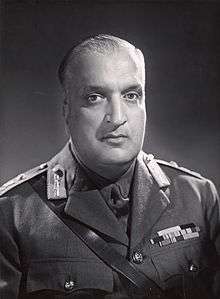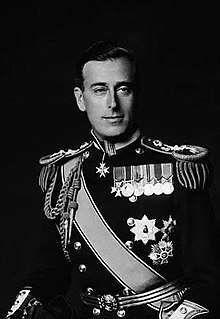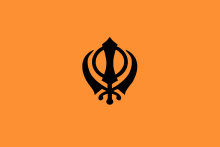Separatist movements of India
Secession in India typically refers to state secession, which is the withdrawal of one or more states from the Republic of India. Some have argued for secession as a natural right of revolution.
Many Independence movements exist with thousands of members, however, with moderate local support and high voter participation in the democratic elections. The Khalistan movement in Punjab was active in the 1980s and the 1990s, but is now largely subdued within India. Insurgency has occurred in North-East India, in the states of Tripura, Meghalaya, Mizoram, Manipur, Assam and Nagaland.
India has introduced several Armed Forces Special Powers Acts (AFSPA) to subdue insurgency in certain parts of the country. The law was first enforced in Manipur and later enforced in other insurgency-ridden north-eastern states. It was extended to most parts of Indian state of Kashmir in 1990 after the outbreak of an armed insurgency in 1989. Each Act gives soldiers immunity in specified regions against prosecution unless the Indian government gives prior sanction for such prosecution. The government maintains that the AFSPA is necessary to restore order in regions like Kashmir and Manipur.[1]
Jammu and Kashmir


Maharaja Hari Singh became the ruler of the princely state of Jammu and Kashmir in 1925, and he was the reigning monarch at the conclusion of the British rule in the subcontinent in 1947. With the impending independence of India, the British announced that the British Paramountcy over the princely states would end, and the states were free to choose between the new Dominions of India and Pakistan or to remain independent. It was emphasized that independence was only a `theoretical possibility' because, during the long rule of the British in India, the states had come to depend on British Indian government for a variety of their needs including their internal and external security.
Jammu and Kashmir had a Muslim majority (77% Muslim by the previous census in 1941[2]). Following the logic of Partition, many people in Pakistan expected that Kashmir would join Pakistan. However, the predominant political movement in the Valley of Kashmir (Jammu and Kashmir National Conference) was secular and was allied with the Indian National Congress since the 1930s. So many in India too had expectations that Kashmir would join India.[3][4] The Maharaja was faced with indecision.[note 1]
On 22 October 1947, rebellious citizens from the western districts of the State and Pushtoon tribesmen from the Northwest Frontier Province of Pakistan invaded the State, backed by Pakistan.[5][6] The Maharaja initially fought back but appealed for assistance to the India,[7][8] who agreed on the condition that the ruler accede to India.[9] Maharaja Hari Singh signed the Instrument of Accession on 26 October 1947 in return for military aid and assistance,[10] which was accepted by the Governor General the next day.[11][12] While the Government of India accepted the accession, it added the proviso that it would be submitted to a "reference to the people" after the state is cleared of the invaders, since "only the people, not the Maharaja, could decide where Kashmiris wanted to live." It was a provisional accession.[13][14][15][note 2]
Once the Instrument of Accession was signed, Indian soldiers entered Kashmir with orders to evict the raiders. The resulting Indo-Pakistani War of 1947 lasted till the end of 1948. At the beginning of 1948, India took the matter to the United Nations Security Council. The Security Council passed a resolution asking Pakistan to withdraw its forces as well as the Pakistani nationals from the territory of Jammu and Kashmir, and India to withdraw the majority of its forces leaving only a sufficient number to maintain law and order, following which a Plebiscite would be held. A ceasefire was agreed on 1 January 1949, supervised by UN observers.[16]
A special United Nations Commission for India and Pakistan (UNCIP) was set up to negotiate the withdrawal arrangements as per the Security Council resolution. The UNCIP made three visits to the subcontinent between 1948 and 1949, trying to find a solution agreeable to both India and Pakistan.[17] It passed a resolution in August 1948 proposing a three-part process. It was accepted by India but effectively rejected by Pakistan.[note 3] In the end, no withdrawal was ever carried out, India insisting that Pakistan had to withdraw first, and Pakistan contending that there was no guarantee that India would withdraw afterward.[18] No agreement could be reached between the two countries on the process of demilitarization.[19]
India and Pakistan fought two further wars in 1965 and 1971. Following the latter war, the countries reached the Simla Agreement, agreeing on a Line of Control between their respective regions and committing to a peaceful resolution of the dispute through bilateral negotiations.
North East India
Assam
The militant organization United Liberation Front of Assam demands a separate country for the indigenous people of Assam. The Government of India had banned the ULFA in 1990 and has officially labelled it as a terrorist group, whereas the US State Department lists it under "Other groups of concern".[20] Military operations against it by the Indian Army that began in 1990 continues until present. In the past two decades, some 10,000 people have died in the clash between the rebels and the government.[21] The Assamese secessionists have protested against the illegal migration from the neighboring regions. Since the mid-20th century, people from present-day Bangladesh (then known as East Pakistan) have been migrating to Assam. In 1961, the Government of Assam passed a legislation making use of Assamese language compulsory; It had to be withdrawn later under pressure from Bengali speaking people in Cachar. In the 1980s the Brahmaputra valley saw a six-year Assam agitation[22] triggered by the discovery of a sudden rise in registered voters on electoral rolls.
The Muslim United Liberation Tigers of Assam (MULTA), established in 1996, advocates a separate country for the Muslims of the region.[23] The United People's Democratic Solidarity (UPDS) demands a sovereign nation for the Karbi people. It was formed in March 1999 with the merger of two militant outfits in Assam's Karbi Anglong district, the Karbi National Volunteers (KNV) and Karbi People’s Front (KPF).[24] The United People's Democratic Solidarity signed a cease-fire agreement for one year with the Union Government on 23 May 2002. However, this led to a split in the UPDS with one faction deciding to continue with its subversive activities while the other commenced negotiations with the Government.
Nagalim
The Nagalim is a proposed independent country for the Naga people. In the 1950s, the Naga National Council led a violent unsuccessful insurgency against the Government of India, demanding a separate country for the Nagas. The secessionist violence decreased considerably after the formation of the Naga-majority Nagaland state, and more militants surrendered after the Shillong Accord of 1975. However, the majority of Nagas, operating under the various factions of National Socialist Council of Nagaland, continue to demand a separate country.
2014 General Elections of India recorded voters turnout of more than 87% in Nagaland which was highest in India.[25]
Tripura
The National Liberation Front of Tripura (or NLFT) is a Tripuri nationalist organisation which seeks for Tripura to secede from India and establish an independent Tripuri state. It has actively participated in the Tripura Rebellion. The NLFT manifesto says that they want to expand what they describe as the Kingdom of God and Christ in Tripura. The Tripura National Volunteers (also known as the Tribal National Volunteers or Tripura National Volunteer Force) was founded in 1978 with assistance from the Mizo National Front.[26]
However, it is perceived by Indian Government that separatist movement lacked people's support as 2014 General elections in India recorded more than 84% voters turnout in Tripura which was one of highest in India.[25]
Indian Punjab
Khalistan

The Khalistan movement aimed to create a separate Sikh country. The territorial definition of the proposed country ranges from the Punjab state of India to the greater Punjab region, including the Indian Punjab, Haryana, Himachal Pradesh and Northern Districts of Rajasthan such as Sri Ganganagar and Hanumangarh.[27][28][29] The movement was mainly active in the Punjab state of India from the 1970s to the early 1990s.
After the partition of India, the majority of the Sikhs migrated from the Pakistani part to the Indian province of Punjab, which then included the parts of the present-day Haryana and Himachal Pradesh. Following India's independence in 1947, The Punjabi Suba Movement led by the Sikh political party Akali Dal led to the trifurcation of the Punjab state. The remnant Punjab state became Sikh-majority and Punjabi-majority. Subsequently, a section of the Sikh leaders started demanding more autonomy for the states, alleging that the Central government was discriminating against Punjab. Although the Akali Dal explicitly opposed the demand for an independent Sikh country, the issues raised by it were used as a premise for the creation of a separate country by the proponents of Khalistan.
In June 1984, the Indian Government ordered a military operation, Operation Blue Star to clear Harmandir Sahib, Amritsar and thirty other Gurdwaras (Sikh Place of Worship) of armed terrorists who were desecrating Gurudwaras by using those as sanctuary. The Indian Army used 3,000 armed troops of the 9th Division of the National Security Guards, 175 Parachute Regiment and artillery units, and 700 CRPF Jawans. During this operation, Indian army had around 83+ casualties with 220 injuries, and 200- 250 Sikh militants were killed. The CBI is considered responsible for seizing historical artifacts from Sikh Reference Library, and burning the empty library afterward. The handling of the operation, damage to the Holy shrine and loss of life on both sides, led to widespread criticism of the Indian Government. The Indian government did this under complete media blockage. However, the eyewitness accounts of survivors revealed the real picture to the public. This lead to widespread distrust and anger against the Indian government and primarily the Indian Prime minister. The Indian Prime Minister Indira Gandhi was assassinated by her two Sikh bodyguards in retaliation. Following her death, thousands of Sikhs were massacred in the 1984 anti-Sikh riots, termed as a genocide by the Sikh groups.[30] The subsequent Punjab insurgency saw several secessionist militant groups becoming active in Punjab, supported by a section of the Sikh diaspora. Indian security forces suppressed the insurgency in the early 1990s, but Sikh political groups such as the Khalsa Raj Party and SAD (A) continued to pursue an independent Khalistan through non-violent means.[31][32][33] Pro-Khalistan organisations such as Dal Khalsa (International) are also active outside India, supported by a section of the Sikh diaspora.
See also
Further reading
- Racine, Jean-Luc (2013). Secessionism in independent India: Failed attempts, irredentism, and accommodations. Secessionism and Separatism in Europe and Asia: To have a state of one’s own. Routledge. pp. 147–163.
References
- ↑ "India campaign over 'draconian' anti-insurgent law". BBC News. 17 October 2011.
- ↑ Snedden 2003.
- ↑ Guha, Ramachandra (2008), India after Gandhi: The History of the World's Largest Democracy, Pan Macmillian, ISBN 0330396110 : "Pakistan naturally expected Kashmir, with its Muslim majority, to join it. India thought that the religious factor was irrelevant, especially since the leading political party, the National Conference, was known to be non-sectarian."
- ↑ Snedden, Christopher (2015), Understanding Kashmir and Kashmiris, Oxford University Press, pp. 172–, ISBN 978-1-84904-342-7 : "Senior Pakistanis, many of whom had once naively simply expected that J&K would join Pakistan, had come to believe that India had been deliberately conniving with Hari Singh to obtain J&K's accession. To try to prevent India's acquisition, some of these Pakistanis sent the Pukhtoons to capture J&K for Pakistan."
- ↑ "Quick guide: Kashmir dispute". BBC News. 29 June 2006. Retrieved 14 June 2009.
- ↑ "Who changed the face of '47 war?". Times of India. 14 August 2005. Retrieved 14 August 2005.
- ↑ http://www.getmistified.com/competition_docs/2013_Topic_I_Kashmir.pdf
- ↑ http://shodhganga.inflibnet.ac.in/bitstream/10603/4425/9/09_chapter%202.pdf
- ↑ Stein, Burton. 1998. A History of India. Oxford University Press. 432 pages. ISBN 0-19-565446-3. Page 368.
- ↑ Šumit Ganguly (13 February 1999). The Crisis in Kashmir: Portents of War, Hopes of Peace. Cambridge University Press. pp. 10–. ISBN 978-0-521-65566-8.
- ↑ "Rediff on the NeT Special: The Real Kashmir Story". Rediff.com. Retrieved 16 April 2013.
- ↑ "Rediff on the NeT: An interview with Field Marshal Sam Manekshaw". Rediff.com. Retrieved 16 April 2013.
- ↑ Varshney 1992, p. 194.
- ↑ Humayun Mirza (1 January 2002). From Plassey to Pakistan: The Family History of Iskander Mirza, the First President of Pakistan. University Press of America. p. 161. ISBN 978-0-7618-2349-0.
- ↑ Nyla Ali Khan (15 September 2010). Islam, Women, and Violence in Kashmir: Between India and Pakistan. Palgrave Macmillan. pp. 30–. ISBN 978-0-230-11352-7.
- ↑ Subramaniam, Arjun (2016), India's Wars: A Military History, 1947–1971, Harper Collins India, ISBN 9351777499 . Excerpt at How the map of Jammu and Kashmir could have been significantly different today, Scroll.in
- ↑ Schofield 2003, p. 70.
- ↑ Varshney 1992, p. 212.
- ↑ Korbel 1953, pp. 506–507.
- ↑ Country Reports on Terrorism, 2006
- ↑ Five killed in Assam bomb blasts - Dawn
- ↑ Hazarika 2003
- ↑ "Muslim United Liberation Tigers of Assam (MULTA)". South Asia Terrorism Portal. Retrieved 2009-08-14.
- ↑ SATP - UPDS
- 1 2 "State-Wise Voter Turnout in General Election 2014". Election Commission of India. Government of India. Press Information Bureau. 21 May 2014. Retrieved 7 April 2015.
- ↑ "Assessment for Tripuras in India", Minorities at Risk Project, UNHCR Refworld, 2003-12-31, retrieved 2009-03-15
- ↑ Crenshaw, Martha (1995). Terrorism in Context. Pennsylvania State University. p. 364. ISBN 978-0-271-01015-1.
- ↑ The foreign policy of Pakistan: ethnic impacts on diplomacy, 1971-1994 ISBN 1-86064-169-5 - Mehtab Ali Shah "Such is the political, psychological and religious attachment of the Sikhs to that city that a Khalistan without Lahore would be like a Germany without Berlin."
- ↑ Amritsar to Lahore: a journey across the India-Pakistan border - Stephen Alter ISBN 0-8122-1743-8 "Ever since the separatist movement gathered force in the 1980s, Pakistan has sided with the Sikhs, even though the territorial ambitions of Khalistan include Lahore and sections of Punjab on both sides of the border."
- ↑ Deol, Harnik (2000). Religion and nationalism in India: the case of the Punjab. Psychology Press. p. 109. ISBN 978-0-415-20108-7. Retrieved 22 July 2011.
- ↑ "Amnesty International report on Punjab". Amnesty International. 20 January 2003. Archived from the original on 3 December 2006. Retrieved 2010-01-11.
- ↑ "Fresh case against Chohan; Khalsa Raj Party office sealed". The Tribune, Chandigarh, India. Tribuneindia.com. Retrieved 2010-01-22.
- ↑ "SAD (A) to contest the coming SGPC elections on Khalistan issue: Mann". PunjabNewsline.com. 14 January 2010. Archived from the original on 15 July 2011. Retrieved 22 January 2010.
Notes
- ↑ Schofield (2003, p. 54): In his letter to Lord Mountbatten on 26 October 1947, the Maharaja wrote, "I wanted to take time to decide which Dominion I should accede... whether it is not in the best interests of both the Dominions and my State to stay independent, of course with cordial relations with both.
- ↑ Kashmiri leader Sheikh Abdullah noted in the UN Security Council in 1948: ""the (plebiscite) offer (was) made by the Prime Minister of India when, I think, he had not the slightest need for making it, for Kashmir was in distress... The Government of India could have easily accepted the accession and said, "All right, we accept your accession and we shall render this help." There was no necessity for the Prime Minister of India to add the proviso while accepting the accession that "India does not want to take advantage of the difficult situation in Kashmir."(Varshney 1992, p. 195)
- ↑ Korbel (1953, p. 502): "Though India accepted the resolution, Pakistan attached to its acceptance so many reservations, qualifications, and assumptions as to make its answer `tantamount to rejection'.